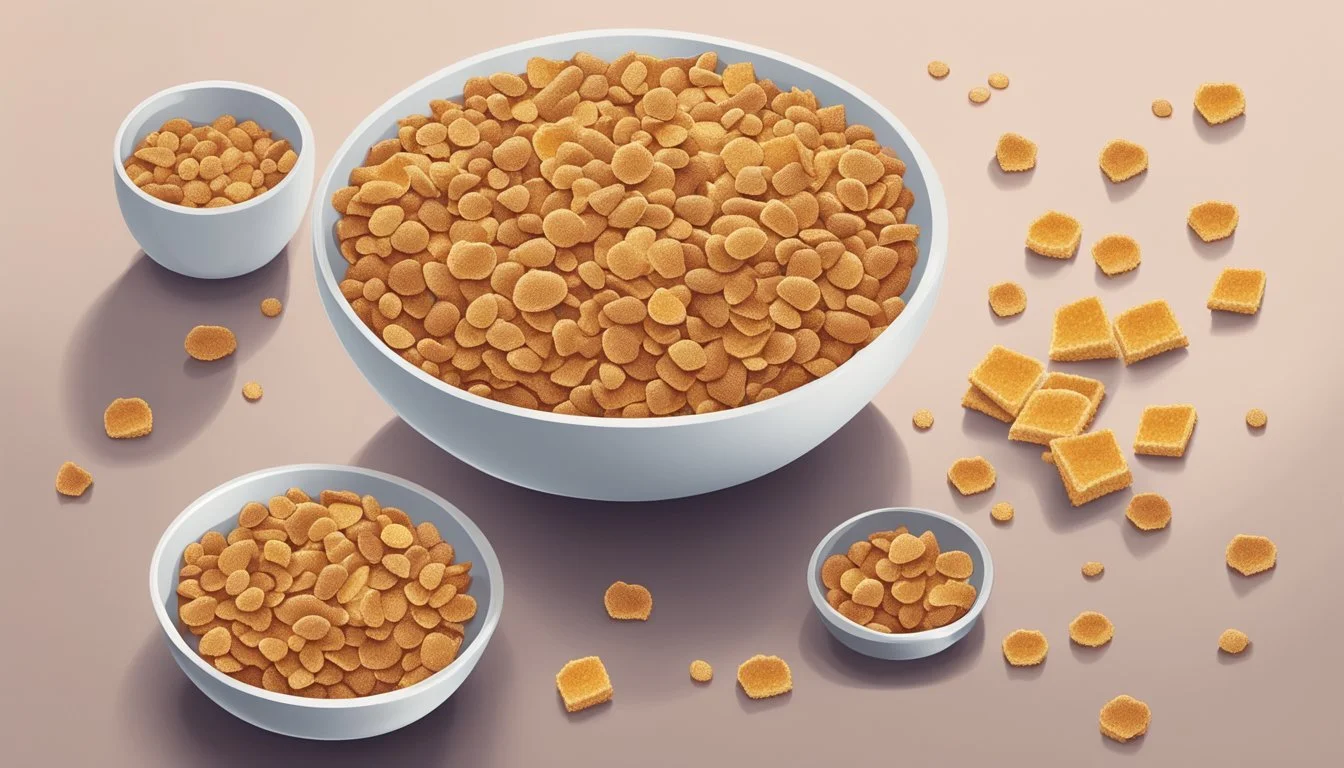Cocoa Pebbles vs Honeycomb
Comparing Two Classic Cereals
This Article is Part of Our Breakfast Cereal Guide with Details on Cocoa Pebbles Nutrition and Honeycomb Nutrition
When it comes to breakfast cereals, the debate between Cocoa Pebbles and Honeycomb is a heated one. For those drawn to intense chocolate flavors, Cocoa Pebbles stands out with its rich, cocoa-infused taste. It’s a favorite among those who enjoy starting their day with a burst of chocolatey goodness, delivering not just in taste but in a satisfying, crunchy texture.
On the other hand, Honeycomb offers a lighter, yet irresistibly sweet option. Its unique honey flavor and airy consistency provide a delightful breakfast experience that appeals to both kids and adults. While Cocoa Pebbles boasts a richer flavor profile, Honeycomb wins points for its simpler, yet equally tantalizing taste.
Comparing the nutritional aspects, Cocoa Pebbles tends to have a higher sugar content, which might not be suitable for everyone. Honeycomb, while also sweet, provides a different balance of calories and sugars, making it a noteworthy contender for those looking for a slightly less indulgent option. This blog post dives deeper into each cereal’s unique features, helping readers decide which one truly deserves a spot in their breakfast routine.
History and Evolution of Breakfast Cereals
Breakfast cereals have played a significant role in shaping morning routines, offering a convenient and often nutritious start to the day. Among them, Cocoa Pebbles and Honeycomb have carved out distinct places in cereal history.
Origins of Cocoa Pebbles and Honeycomb
Cocoa Pebbles emerged in 1971, capturing attention with its rich chocolate flavor and appealing association with the Flintstones cartoon. Initially, the cereal featured cocoa-flavored crispy rice flakes. Early ingredients included rice, sugar, partially hydrogenated vegetable oil, cocoa, salt, caramel color, and BHT for freshness. Its introduction marked a clear move towards creating cereals that were not only tasty but also visually tied to popular culture, enhancing its market appeal.
Honeycomb, on the other hand, debuted in 1965. It stood out with its honey-flavored, corn-based hexagonal pieces. Post Consumer Brands, the creator of Honeycomb, tapped into the growing consumer preference for cereals that were more visually interesting and had a distinct texture. The large, airy texture of each piece was designed to stay crunchy in milk, appealing to both kids and adults looking for a satisfying crunch with a hint of sweetness in their breakfast bowls.
Comparative Nutritional Profiles
Cocoa Pebbles and Honeycomb cereals differ significantly in their nutritional profiles. Key aspects such as caloric content, sugar and fiber levels, and vitamin and mineral fortification highlight their distinct characteristics.
Caloric Content Comparison
Cocoa Pebbles and Honeycomb cereals offer distinct caloric values per serving. Cocoa Pebbles typically contain around 120-130 calories per 3/4 cup serving. In comparison, Honeycomb provides about 150 calories per 1 cup serving.
These values suggest that Cocoa Pebbles are slightly lower in calories when portion sizes are adjusted. For those monitoring caloric intake, Cocoa Pebbles may be a marginally lighter option, though the difference is not vast.
Sugar and Fiber Content
Both cereals show notable differences in sugar and fiber content. Cocoa Pebbles have a sugar content of around 9 grams per serving. Honeycomb has a similar sugar content, approximately 10 grams per serving. Hence, both cereals are relatively high in sugar.
However, there is a stark contrast in fiber content. Honeycomb contains 3.2 grams of fiber per serving, which is significantly higher than Cocoa Pebbles with only 1 gram of fiber per serving. Consumers seeking higher fiber content may prefer Honeycomb.
Vitamin and Mineral Fortification
Vitamins and minerals fortified differ between the two cereals. Cocoa Pebbles are rich in Iron (providing 76% of daily needs), and they also include substantial amounts of Vitamin A, Vitamin C, Calcium, Vitamin B1, Vitamin B2, Vitamin B3, Vitamin B6, Vitamin B12, and Zinc.
Honeycomb, on the other hand, offers higher levels of Vitamin D and Fiber but lacks the robust variety found in Cocoa Pebbles.
Consumers seeking comprehensive vitamin and mineral fortification may lean towards Cocoa Pebbles, while those prioritizing Vitamin D and Fiber might prefer Honeycomb.
Ingredients and Flavors
Cocoa Pebbles and Honeycomb cereals offer distinct ingredients and flavors that cater to different preferences. Below, we explore the core ingredients and flavor profiles of each cereal.
Core Ingredients
Cocoa Pebbles:
Primary Ingredients: Rice, sugar, canola and/or soybean oil
Additives: Cocoa (processed with alkali), salt, caramel color, natural and artificial flavor, BHT (to preserve freshness)
Vitamins and Minerals: Niacinamide (Vitamin B3), reduced iron, zinc oxide, Vitamin A Palmitate, pyridoxine hydrochloride (Vitamin B6), thiamin mononitrate (Vitamin B1)
Honeycomb:
Primary Ingredients: Corn flour blend (whole grain corn flour, corn flour), sugar, oat flour
Additives: Honey, salt, molasses, canola oil, sunflower oil
Vitamins and Minerals: Calcium carbonate, Vitamin C (sodium ascorbate and ascorbic acid), a mix of B vitamins (niacinamide, riboflavin, thiamine mononitrate), folic acid, and iron
Flavor Profiles
Cocoa Pebbles:
Chocolatey Taste: The dominant flavor is cocoa, giving it a rich, chocolaty taste.
Sweetness Level: High due to the considerable sugar content.
Texture: Crunchy texture that becomes softer in milk.
Honeycomb:
Light Honey Flavor: Subtle honey notes make it a milder, more neutral cereal.
Sweetness Level: Moderate, with a combination of honey and sugar.
Texture: Light and airy with a honeycomb structure providing a satisfying crunch.
Both cereals provide distinctive taste experiences, with Cocoa Pebbles appealing to those who prefer a deep chocolate flavor and Honeycomb offering a sweeter, lighter crunch.
Market Position and Brand Strategies
Cocoa Pebbles and Honeycomb occupy distinct places in the breakfast cereal market, with targeted strategies that cater to specific demographics and employ unique advertising techniques.
Target Demographics
Cocoa Pebbles primarily targets children and young teenagers who are attracted to its chocolate flavor and colorful packaging. The cereal's branding and marketing heavily focus on fun and excitement, often featuring cartoon characters like the Flintstones.
Honeycomb, on the other hand, appeals to a broader demographic. While children enjoy its crunchy texture and light sweetness, adults appreciate its lower sugar content compared to other sugary cereals. Honeycomb often markets itself as a slightly healthier breakfast option, balancing appeal across varying age groups.
Advertising Campaigns
Cocoa Pebbles utilizes nostalgic and playful advertising. Commercials often depict children enjoying the cereal alongside animated characters. The brand stays visible through diverse media, including TV, digital platforms, and social media. This strategy helps maintain its strong presence in the competitive cereal aisle.
Honeycomb's advertising emphasizes its long-standing heritage. Campaigns focus on the unique hexagonal shape and satisfying size of the cereal pieces. Honeycomb also touts its suitability for larger appetites, aligning with its branding as an ideal cereal for a hearty breakfast
Through these distinct and effective brand strategies, Cocoa Pebbles and Honeycomb maintain their respective niches within the breakfast cereal market.
Consumer Preferences
In examining consumer preferences between Cocoa Pebbles and Honeycomb, taste tests and reviews offer significant insights, while the popularity of various cereal variants reveals broader trends.
Taste Tests and Reviews
Cocoa Pebbles is frequently praised for its rich cocoa flavor and crisp texture. Many consumers reminisce about the intensity of the chocolate taste, comparing it favorably to competing cereals like Cocoa Puffs.
In contrast, Honeycomb is noted for its unique honey flavor and large, airy pieces. It often draws comparisons to cereals like Frosted Flakes and Lucky Charms due to its sweetness and crunch.
Taste tests suggest that children generally prefer the bold chocolate flavor of Cocoa Pebbles, while adults may favor the nostalgic, honey-sweet taste of Honeycomb. Reviewers often highlight the texture and aftertaste as critical factors influencing their choices.
Cereal Variants Popularity
Cocoa Pebbles has maintained a strong following over the years, with a particular spike in interest from those who grew up enjoying its intense chocolate flavor. It competes well with other chocolate-based cereals such as Cookie Crisp and Chocolate Frosted Flakes. Additionally, Fruity Pebbles, a variant of Cocoa Pebbles, also enjoys significant popularity among fans of fruity cereals.
Honeycomb, while not as varied in its product line, has a dedicated consumer base that appreciates its distinct taste and texture. It stands out among honey-flavored cereals and competes well against cereals like Cinnamon Toast Crunch due to its unique honey flavor and larger pieces.
In terms of sales and consumer interest, Cocoa Pebbles and its variants often lead, but Honeycomb remains a favorite for those seeking a classic honey-filled crunch in their breakfast routine.
Health and Diet Considerations
When comparing Cocoa Pebbles and Honeycomb cereals, it is important to consider how they impact blood sugar levels and their role in modern diets. These factors can influence daily nutrition and affect long-term health.
Impact on Blood Sugar Levels
Cocoa Pebbles contain 9 grams of sugar per serving, potentially leading to a sugar crash after consumption. Honeycomb, on the other hand, has about 10 grams of sugar per serving. Both cereals have a high glycemic index, meaning they can cause quick spikes in blood sugar. This can be concerning for those managing diabetes or other blood sugar conditions.
The net carbs in each cereal can also play a role. Cocoa Pebbles have fewer net carbs than Honeycomb, making them slightly less impactful on blood sugar. Neither cereal offers significant fiber content, which is crucial for moderating blood sugar spikes. People looking to stabilize their blood sugar would benefit from choosing cereals with more whole grains and fiber.
Role in Modern Diets
Cereals like Cocoa Pebbles and Honeycomb are popular in many households but may not align with trends towards more wholesome and balanced breakfasts. Among modern dietary preferences, there is a shift towards products low in added sugars and high in fiber and whole grains.
Neither Cocoa Pebbles nor Honeycomb offers a robust amount of fiber, which is essential for digestive health and sustained energy. For diets that focus on reducing trans fats and artificial ingredients, these cereals may not be the best choice. Brands that provide cereals with fewer grams of sugar and higher quantities of whole grains are more aligned with current nutritional guidelines.
Reducing consumption of refined sugars and opting for cereals with natural ingredients can contribute to better overall health while still enjoying the convenience of a quick breakfast.
Cereal Consumption Patterns
Cocoa Pebbles and Honeycomb Cereal are enjoyed differently based on when and how they are consumed. Key differences emerge between consumption during breakfast and snacking times.
Breakfast vs. Snacking Trends
Breakfast
Cocoa Pebbles are often chosen for the morning meal due to their rich cocoa flavor and vitamin content. The cereal is fortified with essential nutrients like Iron and Vitamin D.
Honeycomb Cereal, known for its honey flavor, is also a popular breakfast choice. It's richer in fiber and often perceived as a healthier morning option.
Snacking
Cocoa Pebbles are frequently eaten as a snack, especially by children and teenagers, thanks to their sweet taste and crunch.
Honeycomb Cereal is less commonly chosen for snacking. Its larger pieces make it less convenient for quick, on-the-go consumption compared to Cocoa Pebbles.
Environmental and Sustainability Aspects
When comparing Cocoa Pebbles and Honeycomb cereals, it is crucial to consider their environmental impact and efforts towards sustainability. This includes aspects related to the production of ingredients and the packaging used.
Production
Cocoa production, a primary ingredient in Cocoa Pebbles, has raised concerns about socio-economics and environmental sustainability. Initiatives like the Cocoa and Forests Initiative aim to address these issues by promoting sustainable farming practices. These involve using high-yielding, pest-resistant cocoa varieties and integrated pest management to reduce chemical inputs and biodiversity loss. In contrast, Honeycomb focuses on honey production, which has a less intensive impact on land use and typically utilizes bees, an essential species for pollination and ecosystem health.
Packaging
Both cereals emphasize the importance of sustainable and recyclable packaging. Post, the manufacturer of both products, has made strides toward incorporating recyclable materials in its packaging. This includes reducing plastic usage and opting for more environmentally friendly materials. Furthermore, both brands strive to adopt water conservation practices during packaging processes to minimize their environmental footprint. Attention to these details reflects their commitment to enhancing sustainability.
Their efforts in these areas highlight the importance of addressing both ingredient sourcing and packaging to mitigate environmental impacts.
The Future of Breakfast Cereals
The breakfast cereal market continues to evolve, with new innovations redefining how consumers interact with their morning routines. Companies are focusing on health benefits, convenience, and flavor variety to appeal to a broader audience.
Innovations in Cereal Products
Cereal companies like Post, Kashi, and General Mills are leading the way. Post's introduction of Cereal Snacks such as Cocoa Pebbles Crisps and Honeycomb Big Bites shows a shift towards on-the-go consumption. These crisps offer the same flavors as traditional cereals but in a portable format.
Kashi and Great Grains are emphasizing health benefits. Products like Banana Nut Crunch and Blueberry Morning incorporate whole grains and natural ingredients. This trend aligns with a growing consumer demand for nutritious, less processed options.
Flavors and nostalgic brands remain crucial. General Mills continues to innovate with Reese's Puffs and Oreo O's, appealing to both kids and adults. Traditional brands like Shredded Wheat and Wheaties are being revamped with new flavors and health-focused formulations to stay relevant.
Environmental sustainability is also key. Companies are exploring eco-friendly packaging and sustainable sourcing. This reflects a broader industry trend towards reducing environmental impact and meeting consumer demand for responsible production practices.
These innovations indicate an exciting future for breakfast cereals, blending health, convenience, and flavor while addressing sustainability concerns.








